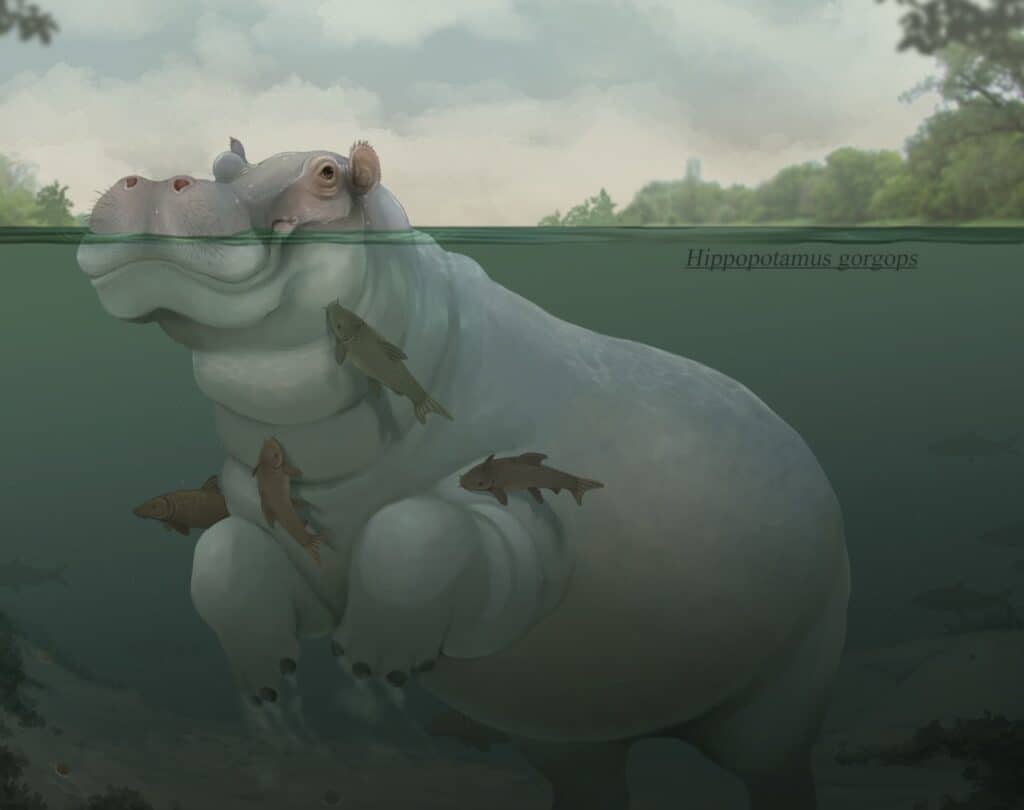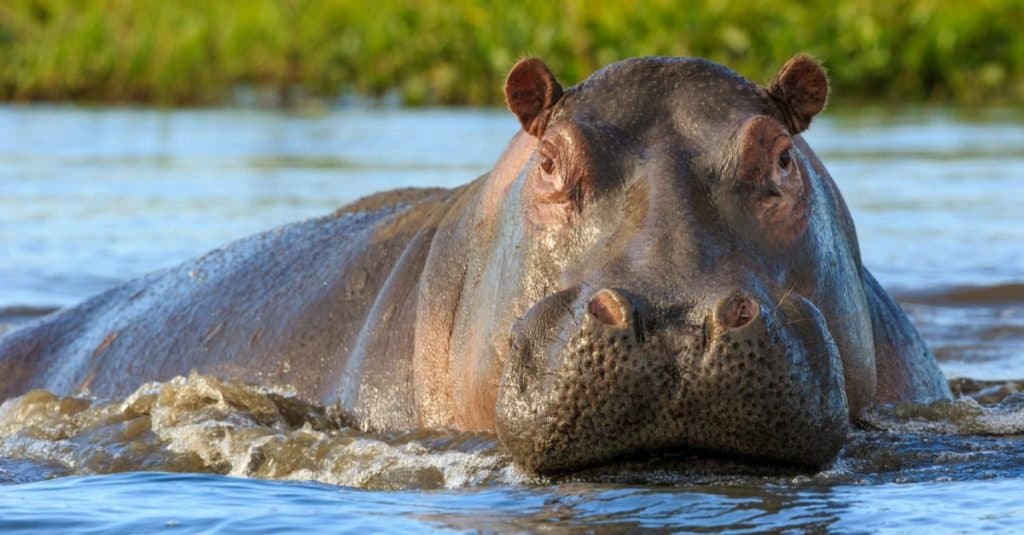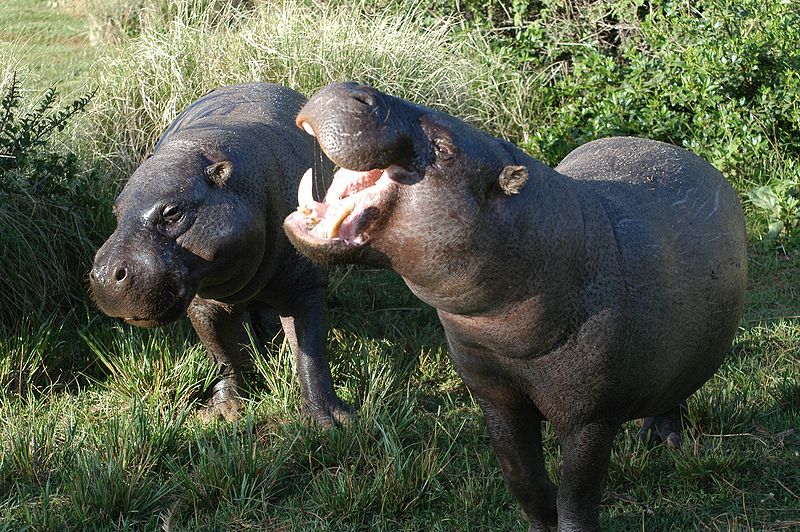Modern hippopotamuses are among the strangest and most famous of all the “classic” African animals. They are beloved by kids everywhere and are among the largest and plumpest of any animal alive today. These massive creatures are also among the deadliest on the planet and regularly go head-to-head with the largest crocodiles in the world. Although the hippos we have today are no small sight, they aren’t actually the largest in history. To learn about that individual, we need to go back a few hundred thousand years ago. Let’s discover the largest prehistoric hippo to ever live!
What was the largest prehistoric hippo to ever live?

Hippopotamus gorgops was the largest member of the Hippopotamidae family to ever live.
©Amberghini / CC BY-SA 4.0 – License
The largest prehistoric hippo to ever live was an individual known as Hippopotamus gorgops.
Hippopotamus gorgops is an extinct species of hippo that lived a few hundred thousand years ago. It was extremely similar to the modern-day hippo in behavior, despite being significantly larger. This hippopotamus belonged to the Hippopotamidae family and shared traits with all members of the family, namely, being stout, bare-skinned, and semi-aquatic. All members of the Hippopotamidae family are related to cetaceans (whales and dolphins), including the two species of hippo that are still alive today.
Hippopotamus gorgops is listed as the largest-known land-dwelling artiodactyl. An artiodactyl is an even-toed ungulate (hoofed animal) that places its weight on two of its five toes. Famous artiodactyls include the American bison, boar, red deer, giraffe, and even whales! Whales are classified under this group since they evolved from even-toed ungulates, despite their lack of hooves.
How big was Hippopotamus gorgops?

Hippopotamus gorgops was 14 feet long and weighed 4.5 tons.
©Radek Borovka/Shutterstock.com
Based on models created from fossil evidence, Hippopotamus gorgops was truly a massive creature. It is estimated to have been around 14 feet long and stood 7 feet tall at the shoulder. Additionally, it weighed between 8,600 and 9,000 lbs, or 4.5 tons.
For reference, the largest species of rhino is the Indian rhinoceros. These animals top out around 4,900 lbs, or a little over half the weight of a full-grown Hippopotamus gorgops. Asian elephants usually weigh 8,800 lbs, while full-grown African elephants (the largest land animals alive) weigh 13,000 lbs at their largest.
When and where did Hippopotamus gorgops live?
Hippopotamus gorgops likely evolved during the Late Pliocene and went extinct sometime during the Middle Pleistocene. The end of the Pliocene was around 2.58 million years ago, while the Middle Pleistocene was around 0.5 million years ago. Scientists aren’t sure exactly when Hippopotamus gorgops went extinct, but it was before the Ice Age.
The first ancestors of Hippopotamus gorgops appeared in Africa during the Late Miocene, upwards of 5 million years ago. The first individuals to migrate to Europe moved during the early Pliocene, where the first fossils were found. By their extinction, Hippopotamus gorgops had a range that potentially extended from Africa all the way through Europe, via the middle east (particularly along the Mediterranean).
Modern hippos vs Hippopotamus gorgops

The main difference between a modern hippo and Hippopotamus gorgops is size and the presence of eye stalks.
©Gaston Piccinetti/Shutterstock.com
Although modern hippos (the common hippo) and Hippopotamus gorgops are related, there are a few differences, however slight.
The first and most notable is the difference in size. As mentioned, Hippopotamus gorgops was 14 feet long and weighed between 8,600 and 9,000 lbs. The largest modern hippos generally measure 10 feet long and weigh up to 4,000 lbs, or about half of Hippopotamus gorgops.
One important anatomical difference can be seen in their eyes. Hippopotamus gorgops had distinct “stalks” where their eyes rested, allowing them to hold them above the water while staying mostly submerged. Their eyes were physically above the skull, similar to a periscope on a submarine. Common hippos have eyes that rest on the top of their head, but they don’t have stalks like Hippopotamus gorgops did.
Besides the difference in proportions and eyes, Hippopotamus gorgops was extremely similar to the common hippo. In regards to lifestyle, Hippopotamus gorgops was semiaquatic and spent similar amounts of time in the water and on land when compared to modern hippos. In fact, scientists believe that they likely behaved identically to today’s hippos.
Other examples of prehistoric hippos

The common and pygmy hippos are the only extant species of hippo.
©Chuckupd – Public Domain – License
Although Hippopotamus gorgops was the largest prehistoric hippo, it wasn’t the only one! There are two extant (still living) species of hippo, the common and the pygmy hippo. Common hippos are found in small pockets across sub-Saharan Africa, while pygmy hippos are found in the forests and swamps of West Africa.
A list of prehistoric hippos:
- Genus Hippopotamus – true hippopotamuses
- Hippopotamus antiquus – mainland Europe & British Isles; Pleistocene
- Hippopotamus creutzburgi – Crete; Pleistocene
- Hippopotamus minor[a] – Cyprus; Pleistocene to Holocene
- Hippopotamus melitensis – Malta; Pleistocene
- Hippopotamus pentlandi – Sicily; Pleistocene
- Hippopotamus laloumena – Madagascar; Holocene
- Hippopotamus gorgops – Africa and mainland Europe; Late Miocene–Middle Pleistocene
- Tentatively placed into Hippopotamus:
- Hippopotamus aethiopicus – Kenya & Ethiopia; Pliocene -Pleistocene
- Hippopotamus afarensis – formerly genus Trilobophorus
- Hippopotamus behemoth – Israel, Early Pleistocene
- Hippopotamus kaisensis – Central Africa; Pliocene
- Hippopotamus sirensis – Morocco & Algeria; Pleistocene
- Genus Hexaprotodon – hexaprotodons or Asian hippopotamuses
- Hexaprotodon bruneti – Ethiopia; Pliocene
- Hexaprotodon coryndoni – Ethiopia; Pliocene
- Hexaprotodon crusafonti – Spain; Late Miocene (syn. Hexaprotodon primaevus)
- Hexaprotodon hipponensis – Algeria
- Hexaprotodon imagunculus – Uganda and Congo; Pliocene
- Hexaprotodon iravaticus – Myanmar; Pliocene – Pleistocene
- Hexaprotodon karumensis – Kenya and Eritrea; Pleistocene
- Hexaprotodon namadicus – India; (possibly same as Hex. palaeindicus)
- Hexaprotodon palaeindicus – India;
- Hexaprotodon pantanellii – Italy; Pliocene
- Hexaprotodon protamphibius – Kenya and Chad; Pliocene
- Hexaprotodon siculus –
- Hexaprotodon sivajavanicus – Indonesia
- Hexaprotodon sivalensis – India
- Hexaprotodon sp. (undescribed) – Myanmar
- Genus Archaeopotamus – formerly included in Hexaprotodon
- Archaeopotamus harvardi – Arabian Peninsula and Central Africa; Miocene – Pliocene
- Archaeopotamus lothagamensis – Kenya; Miocene
The photo featured at the top of this post is © Martin Mecnarowski/Shutterstock.com
Sources
- Scientific American, Available here: https://blogs.scientificamerican.com/tetrapod-zoology/a-quick-history-of-hippopotamuses/
- Prehistoric Fauna, Available here: https://prehistoric-fauna.com/Hippopotamus-gorgops
- Zoological Journal of the Linnean Society, Available here: https://academic.oup.com/zoolinnean/article/143/1/1/2726725?login=false
Thank you for reading! Have some feedback for us? Contact the AZ Animals editorial team.






